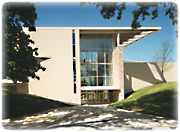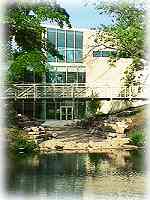Peggy Notebaert Nature Museum
of The Chicago Academy of Sciences
2430 North Cannon Drive
Chicago, Illinois
Phone: 773-755-5100
TTY:

Listing sponsored by
KappaElastin™
Scientific
Breakthrough. No Shots
Science response to skin aging.
www.kappaelastin.com
2430 North Cannon Drive
Chicago, Illinois
Phone: 773-755-5100
TTY:

Founded in 1857, the Chicago Academy of Sciences was Chicago's first museum and natural science research organization. Dedicated to its mission of achieving scientific literacy for all citizens, the academy is particularly know for its cutting-edge science education and global research programs. The Peggy Notebaert Nature Museum, a state-of-the-art environmental museum, opened in October 1999. The museum explores the biodiversity of the Midwest through exhibitions and encourages visitors to take a closer look at their environment and help them connect with science and the natural world through interactive activities.

Exhibits at the Peggy Notebaert Nature Museum share a common philosophy--that people learn best by questioning, sharing, discussing, and doing. Each exhibit presents a host of intriguing situations which challenge visitors to connect with science and the natural world.

The Museum's permanent exhibits are:
Judy Istock Butterfly Haven
What is the difference between a moth and a monarch? What do butterflies eat? You will find the answers to these questions and more in the 2,700 square foot Judy Istock Butterfly Haven that includes a 28-foot tall greenhouse aflutter with live butterflies and moths! Visit over 500 butterflies representing over a dozen species native to the Midwest. Adjacent to the greenhouse are interactive graphics that encourage visitors to learn about the lifecycles, migration, and behavior of one of nature's most magical creatures. In addition, the Museum is home to the only breeding lab of its kind in North America.
City Science
Gain a whole new perspective on nature when you tour this 3,000 square foot, 2-story house. The infrastructure has been peeled away so you can meet the creatures that inhabit every city home. You will understand how every time you flip a switch or turn up the heat in your house, you are tapping into processes being conducted hundreds or even thousands of miles away. City Science provides an opportunity to investigate the relationships that link urban living to the natural world.
SBC Environmental Central
Help us test this ground-breaking exhibit before we go "live." Each evaluation session is one hour in length and will take place in the forum. Topic currently under development: drought.
There's a drought in the Midwest. Fix it. You have 40 minutes. It's not a game. It's real life. and it's in your hands.
Inside Environmental Central you grapple with tough issues--like droughts, floods, urban sprawl--and plan for the future. How would you avert a water shortage in the year 2010? Using the latest data provided by the Environmental Central Web site, and through group discussions facilitated by Academy staff, try to sort out a solution to one of today's large-scale environmental problems. After 40 minutes, understand the complexity of solving serious environmental problems and the long-term results of interacting with nature.
C. Paul Johnson Family Water Lab
Enter the C. Paul Johnson Family Charitable Foundation Water Lab through a flowing wall of water alive with microbial images. Once in Water Lab, an interactive model of an urban river system demonstrates how human impact shapes our waterways. A giant stream table allows you to engineer your own river system, and we've built a water chemistry lab so that you can study the composition of water sampled from around the area.
Wilderness Walk
Over the past 150 years, the ecology of the Midwest has been radically altered by human settlement. While in the mid-1800's most of Illinois was prairie, today only tiny remnants remain. Hundreds of square miles of woodland have long since been converted to farms, towns, and cities. These ecosystems provided habitat for hundreds of species of animals and plants. Where are they now?
Children's Gallery
Where can a four-year-old dig under the prairie, or swim into a beaver lodge and not get soaked? In the Children's Gallery, a kid-friendly area designed specially for children three to eight, 1,300 square feet of safe-space provide a place where young visitors can explore two native environments: a wetland and a prairie. Underground and above ground exhibits take kids though a world of scientific fun.
Outdoor Exhibit
Outdoors we've planted the grounds around the museum with plant communities that used to dominate the Midwestern landscape. Be sure to visit the prairie wildflowers growing near Fullerton Parkway and the butterfly garden along the south edge of the North Pond.
We're wired!
Over 50 computers in the Peggy Notebaert Nature Museum are hooked up to the Internet and to other electronic information resources. Discover the worlds of ecology, biology, geology, and a host of other topics.
Directions:
Driving Directions to the Museum
(Street parking available. Parking in the Lincoln Park Zoo lot on Cannon Drive)
Coming from the North Shore:
Take Sheridan Rd. to Lake Shore Drive heading South. Exit at Fullerton Avenue. Proceed West on Fullerton for one block to Cannon Drive.
Coming from the North Via I-94:
Take the Edens Expressway (I-94) East to the Kennedy Expressway (I-90/94) East. Exit at Fullerton Avenue. Proceed East on Fullerton for 2 miles to Cannon Drive.
Coming from the Northwest or O'Hare Airport via I-90:
Take the Kennedy Expressway (I-90/94) East. Exit at Fullerton Avenue. Proceed East on Fullerton for 2 miles to Cannon Drive.
Coming from the West via I-290:
Take the Eisenhower Expressway (I-290) East to the Kennedy Expressway (I-90/94), heading toward Wisconsin. Exit at Fullerton Avenue. Proceed East on Fullerton for 2 miles to Cannon Drive.
Coming from the Southwest or Midway Airport via I-55:
Take the Stevenson Expressway (I-55) North to Lake Shore Drive, heading North. Exit at Fullerton Avenue. Proceed West on Fullerton for one block to Cannon Drive.
Coming from the South via I-57:
Take I-57 North to I-94 West. Exit at Fullerton Avenue. Proceed East on Fullerton for 2 miles to Cannon Drive.
Lewis Crampton, Acting President
Do you have any additional
comments concerning this site?
Do you wish to receive some information on
how to get your museum
on the Museums Tour?